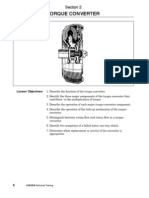Statement:: PROBLEM 2-35
Statement:: PROBLEM 2-35
Uploaded by
GUSTAVO VINICIUS VIEIRA MELLOCopyright:
Available Formats
Statement:: PROBLEM 2-35
Statement:: PROBLEM 2-35
Uploaded by
GUSTAVO VINICIUS VIEIRA MELLOOriginal Title
Copyright
Available Formats
Share this document
Did you find this document useful?
Is this content inappropriate?
Copyright:
Available Formats
Statement:: PROBLEM 2-35
Statement:: PROBLEM 2-35
Uploaded by
GUSTAVO VINICIUS VIEIRA MELLOCopyright:
Available Formats
Kinematics and Dynamics of Machinery SOLUTION MANUAL 2-35-1
PROBLEM 2-35
Statement: Figure P2-16 shows a manual press used to compact powdered materials. Sketch its kinematic
diagram, determine its mobility and its type (i.e., is it a fourbar, a Watt's sixbar, a Stephenson's
sixbar, an eightbar, or what?) Use reverse linkage transformation to determine its pure
revolute-jointed equivalent linkage.
Solution: See Figure P2-16 and Mathcad file P0235.
1. Sketch a kinematic diagram of the mechanism. The mechanism is shown on the left and a kinematic model of it
is sketched on the right. It is a fourbar linkage with 1 DOF (see below).
3 4
3
2
2
O2
O2
2. Use equation 2.1c to determine the DOF (mobility). There are 4 links, 3 full pin joints, 1 full sliding joint, and 0
half joints. This is a fourbar slider-crank.
Kutzbach's mobility equation (2.1c)
Number of links L
4
Number of full joints J1
4
Number of half joints J2
0
M
3
( L 1) 2
J1 J 2 M 1
3. Use rule 1 (on page 42) to transform the full sliding joint to a full pin joint for no change in DOF. The resulting
kinematically equivalent linkage has 4 links, 4 full pin joints, no half joints, and is shown below.
4
O4
2
O2
You might also like
- 6 Speed Automatic Transaxle AWF21 PDFDocument66 pages6 Speed Automatic Transaxle AWF21 PDFMihai Mitrea100% (5)
- Robert L. Norton Design of Machinery SOLUTIONS MANUAL PDFDocument5 pagesRobert L. Norton Design of Machinery SOLUTIONS MANUAL PDFAb17% (6)
- Subaru 2004 Forester XT Transmission TCM IO PinoutDocument3 pagesSubaru 2004 Forester XT Transmission TCM IO PinoutMarco Cisternas100% (3)
- TAMD61a-72j-A WM TechnicaldataDocument36 pagesTAMD61a-72j-A WM TechnicaldatajaumegusNo ratings yet
- Operation & Maintenance Manual For DPIS-1-HED (SN 202839) PDFDocument257 pagesOperation & Maintenance Manual For DPIS-1-HED (SN 202839) PDFFJ OscarNo ratings yet
- Aurora 280 BulletinDocument16 pagesAurora 280 BulletinMarcus BaltesNo ratings yet
- Kansai Special Rx-9000 Instructions ManualDocument35 pagesKansai Special Rx-9000 Instructions Manualhermitagecinq50% (2)
- Statement:: PROBLEM 2-34Document1 pageStatement:: PROBLEM 2-34GUSTAVO VINICIUS VIEIRA MELLONo ratings yet
- Statement:: Problem 2-1Document2 pagesStatement:: Problem 2-1Gustavo CopplaNo ratings yet
- Statement:: Problem 2-1Document2 pagesStatement:: Problem 2-1GUSTAVO VINICIUS VIEIRA MELLONo ratings yet
- Statement: Solution:: PROBLEM 2-21Document3 pagesStatement: Solution:: PROBLEM 2-21GUSTAVO VINICIUS VIEIRA MELLONo ratings yet
- Statement:: PROBLEM 2-14Document1 pageStatement:: PROBLEM 2-14GUSTAVO VINICIUS VIEIRA MELLONo ratings yet
- Statement:: PROBLEM 2-13Document1 pageStatement:: PROBLEM 2-13GUSTAVO VINICIUS VIEIRA MELLONo ratings yet
- Solutions Manual To Accompany Machine Design 5th Edition 013335671xDocument2 pagesSolutions Manual To Accompany Machine Design 5th Edition 013335671xantonybestin94No ratings yet
- Experiment No. - 2: B.S.A. College of Engg. & Technology MathuraDocument2 pagesExperiment No. - 2: B.S.A. College of Engg. & Technology MathuraROHIT SRIVASTAVNo ratings yet
- Statement:: PROBLEM 2-32Document1 pageStatement:: PROBLEM 2-32GUSTAVO VINICIUS VIEIRA MELLONo ratings yet
- Statement: Solution:: Problem 2-8Document4 pagesStatement: Solution:: Problem 2-8Dio ChanNo ratings yet
- Statement:: PROBLEM 2-30Document1 pageStatement:: PROBLEM 2-30GUSTAVO VINICIUS VIEIRA MELLONo ratings yet
- A 70 MHZ 270 MHZ Electrical Tunable LC Bandpass FilterDocument7 pagesA 70 MHZ 270 MHZ Electrical Tunable LC Bandpass FilterAmador Garcia IIINo ratings yet
- D 4 Development of Beam Equations: Figure 4-16 Fixed-Fixed Beam Subjected To Applied Force and MomentDocument1 pageD 4 Development of Beam Equations: Figure 4-16 Fixed-Fixed Beam Subjected To Applied Force and MomentAHMED SHAKERNo ratings yet
- T-23 System of ParticlesDocument3 pagesT-23 System of ParticlesShashi Shekhar TripathiNo ratings yet
- Assig3 11Document3 pagesAssig3 11Sean BotelhoNo ratings yet
- Hitung Dan Gambarkan BMD, SFD, NFD Struktur Dibawah Ini, Menggunkan Metode MatriksDocument7 pagesHitung Dan Gambarkan BMD, SFD, NFD Struktur Dibawah Ini, Menggunkan Metode MatriksraisalfarizNo ratings yet
- Gen Meta JAP v4Document15 pagesGen Meta JAP v4juee chandrachudNo ratings yet
- Narayana - 16!06!2022 - Outgoing SR - Jee Main Model Gtm-11 - QuesDocument20 pagesNarayana - 16!06!2022 - Outgoing SR - Jee Main Model Gtm-11 - QuesShreyas VedantiNo ratings yet
- Four Bar MechanismDocument12 pagesFour Bar Mechanismtudoralex224617No ratings yet
- MCEN3005 Lecture 4 NotesDocument18 pagesMCEN3005 Lecture 4 NotesDileeka DiyabalanageNo ratings yet
- HW 11Document2 pagesHW 11qurriyatus zahroNo ratings yet
- Dynamics of Bridge - SDOFDocument28 pagesDynamics of Bridge - SDOFJoe JamesonNo ratings yet
- n1 MATRIX ANALYSISDocument28 pagesn1 MATRIX ANALYSISarjungireesh789No ratings yet
- Buckling Loads of Columns With Gradually Changing Cross-Section Subjected To Combined Axial LoadingDocument12 pagesBuckling Loads of Columns With Gradually Changing Cross-Section Subjected To Combined Axial LoadingMEER MUSTAFA ALINo ratings yet
- Convergence Behavior of The MITC3+ Triangular Shell ElementDocument6 pagesConvergence Behavior of The MITC3+ Triangular Shell ElementhungNo ratings yet
- Problemas AtkinsDocument2 pagesProblemas AtkinsAlberto SandNo ratings yet
- AFEM Part 4Document16 pagesAFEM Part 4Mohameed AhmedNo ratings yet
- 7 - Stiffness Method For Frame3333Document43 pages7 - Stiffness Method For Frame3333Anonymous yrcU1kNo ratings yet
- Statement: Solution:: Problem 2-8Document1 pageStatement: Solution:: Problem 2-8GUSTAVO VINICIUS VIEIRA MELLONo ratings yet
- 22MMD12Document3 pages22MMD12sudhirNo ratings yet
- Mecanismos ProblemaDocument2 pagesMecanismos ProblemaManuel ChavezNo ratings yet
- (@NEETpassionate) Aakash Mock Test - DDocument19 pages(@NEETpassionate) Aakash Mock Test - DShankhayan DuttaNo ratings yet
- Rad FourierDocument10 pagesRad Fourierpapuca papucaNo ratings yet
- Rotational MotionDocument6 pagesRotational Motionkunalsingh4766No ratings yet
- Assignment3 Writeup PDFDocument10 pagesAssignment3 Writeup PDFLeonardo KnuppNo ratings yet
- Fetching Trajectory Planning of Explosive Ordnance Disposal RobotDocument14 pagesFetching Trajectory Planning of Explosive Ordnance Disposal RobotLamiss HamdNo ratings yet
- Balancing of Four-Bar Linkages Using Maximum Recursive Dynamic AlgorithmDocument17 pagesBalancing of Four-Bar Linkages Using Maximum Recursive Dynamic AlgorithmThaiHuynhNgocNo ratings yet
- (F.N. Cogswell) Polymer Melt Rheology A Guide For PDFDocument197 pages(F.N. Cogswell) Polymer Melt Rheology A Guide For PDFSherafghan Iftikhar100% (1)
- The Analysis of Beams & Frames: Iii) Beams and Frames Subjected To Shear Force, Bending Moment and Axial ForcesDocument73 pagesThe Analysis of Beams & Frames: Iii) Beams and Frames Subjected To Shear Force, Bending Moment and Axial Forcessohail ahmedNo ratings yet
- Statement: Solution:: PROBLEM 2-28Document1 pageStatement: Solution:: PROBLEM 2-28GUSTAVO VINICIUS VIEIRA MELLONo ratings yet
- Finite Element Method: Beam AnalysisDocument10 pagesFinite Element Method: Beam AnalysisZaffira RahmanNo ratings yet
- Modeling A Beam (I) Analysis With Pro/Mechanica StructureDocument55 pagesModeling A Beam (I) Analysis With Pro/Mechanica StructureakinojohnkennedyNo ratings yet
- Gibbs & Apell EquationsDocument9 pagesGibbs & Apell EquationsYeizerNo ratings yet
- Four Bar MechanismDocument19 pagesFour Bar MechanismCleves AxiomaNo ratings yet
- Articulo 1 PDFDocument11 pagesArticulo 1 PDFIntelectual LoaizaNo ratings yet
- RM 2018 2 Pag 16 LeDocument5 pagesRM 2018 2 Pag 16 Lele namNo ratings yet
- DPP 69 Rotation 16-11-2022 - ANSDocument2 pagesDPP 69 Rotation 16-11-2022 - ANSneoisonlyoneNo ratings yet
- Advanced Finite Element Beams Theory & CalculationsDocument20 pagesAdvanced Finite Element Beams Theory & CalculationsNathaji ShelkeNo ratings yet
- 4 Lecture Notes-4 BEM2053 EM218 - Additional NotesXDocument26 pages4 Lecture Notes-4 BEM2053 EM218 - Additional NotesXMuhammad Abdullah ImranNo ratings yet
- Organic Light-Emitting Transistors: Towards the Next Generation Display TechnologyFrom EverandOrganic Light-Emitting Transistors: Towards the Next Generation Display TechnologyNo ratings yet
- Monoidal Category Theory: Unifying Concepts in Mathematics, Physics, and ComputingFrom EverandMonoidal Category Theory: Unifying Concepts in Mathematics, Physics, and ComputingNo ratings yet
- Condition A B S Minab L Maxab SL S L PQ A B C D SL Return SL PQ If Return SL PQ If Return OtherwiseDocument1 pageCondition A B S Minab L Maxab SL S L PQ A B C D SL Return SL PQ If Return SL PQ If Return OtherwiseGUSTAVO VINICIUS VIEIRA MELLONo ratings yet
- Statement:: PROBLEM 2-43Document1 pageStatement:: PROBLEM 2-43GUSTAVO VINICIUS VIEIRA MELLONo ratings yet
- Statement:: PROBLEM 2-56Document1 pageStatement:: PROBLEM 2-56GUSTAVO VINICIUS VIEIRA MELLONo ratings yet
- Statement:: PROBLEM 2-44Document1 pageStatement:: PROBLEM 2-44GUSTAVO VINICIUS VIEIRA MELLONo ratings yet
- Statement:: PROBLEM 2-53Document1 pageStatement:: PROBLEM 2-53GUSTAVO VINICIUS VIEIRA MELLONo ratings yet
- Statement: Solution:: Problem 2-7Document2 pagesStatement: Solution:: Problem 2-7GUSTAVO VINICIUS VIEIRA MELLO100% (1)
- Statement:: PROBLEM 2-15Document1 pageStatement:: PROBLEM 2-15GUSTAVO VINICIUS VIEIRA MELLONo ratings yet
- Statement:: PROBLEM 2-32Document1 pageStatement:: PROBLEM 2-32GUSTAVO VINICIUS VIEIRA MELLONo ratings yet
- Statement:: PROBLEM 2-30Document1 pageStatement:: PROBLEM 2-30GUSTAVO VINICIUS VIEIRA MELLONo ratings yet
- Statement:: PROBLEM 2-18Document1 pageStatement:: PROBLEM 2-18GUSTAVO VINICIUS VIEIRA MELLONo ratings yet
- Statement:: PROBLEM 2-11Document1 pageStatement:: PROBLEM 2-11GUSTAVO VINICIUS VIEIRA MELLONo ratings yet
- Statement: Solution:: Problem 2-8Document1 pageStatement: Solution:: Problem 2-8GUSTAVO VINICIUS VIEIRA MELLONo ratings yet
- Statement: Solution:: PROBLEM 2-28Document1 pageStatement: Solution:: PROBLEM 2-28GUSTAVO VINICIUS VIEIRA MELLONo ratings yet
- Statement:: PROBLEM 2-13Document1 pageStatement:: PROBLEM 2-13GUSTAVO VINICIUS VIEIRA MELLONo ratings yet
- Statement:: PROBLEM 2-27Document1 pageStatement:: PROBLEM 2-27GUSTAVO VINICIUS VIEIRA MELLONo ratings yet
- Statement:: Inversions. How Many Distinct Inversions Does The Linkage in Row 4, Column 1 Have?Document1 pageStatement:: Inversions. How Many Distinct Inversions Does The Linkage in Row 4, Column 1 Have?GUSTAVO VINICIUS VIEIRA MELLONo ratings yet
- "Standard"Separate Vacuum Hopper Loader - SAL G PDFDocument34 pages"Standard"Separate Vacuum Hopper Loader - SAL G PDFJD126No ratings yet
- 303-04b Fuel Charging and Controls TurbochargerDocument16 pages303-04b Fuel Charging and Controls TurbochargerDarren ANo ratings yet
- SCX180 CatalogDocument32 pagesSCX180 CatalogcoelhoclaudiosNo ratings yet
- Toyota Torque Converter TrainingDocument15 pagesToyota Torque Converter TrainingBruce Truax100% (2)
- CAT Generator Set SpecificationsDocument6 pagesCAT Generator Set SpecificationsBryle James BialaNo ratings yet
- Global Service LearningDocument63 pagesGlobal Service LearningEslamAldenAbdo100% (4)
- Model 50 (TS) Series Soda Post-Mix Refrigeration Unit Parts List For ModelsDocument8 pagesModel 50 (TS) Series Soda Post-Mix Refrigeration Unit Parts List For ModelsAmauri RogérioNo ratings yet
- Amico-As-Air-And-Vacuum-Systems-BrochureDocument20 pagesAmico-As-Air-And-Vacuum-Systems-BrochureLuis PalaciosNo ratings yet
- Detroit 71 Series Engines 3cyl 4cyl 6cyl OperationsDocument112 pagesDetroit 71 Series Engines 3cyl 4cyl 6cyl OperationsgirfanovNo ratings yet
- Electrolux WE220, FLE 220 Spare Parts LaundryDocument208 pagesElectrolux WE220, FLE 220 Spare Parts LaundryAnonymous vLBPWHPNo ratings yet
- CP271 SN 23620368 - 23620699Document176 pagesCP271 SN 23620368 - 23620699Felipe Douglas da Silva100% (1)
- Operation 2Document126 pagesOperation 2Abdelrahman SharafNo ratings yet
- Ijme V2i6p107Document5 pagesIjme V2i6p107Atthuru ManikantaNo ratings yet
- SL2022 727Document3 pagesSL2022 727Jannik GårdboNo ratings yet
- AMSOIL Formula 4stroke® 10W40 Synthetic Scooter Oil (ASO)Document2 pagesAMSOIL Formula 4stroke® 10W40 Synthetic Scooter Oil (ASO)amsoildealerNo ratings yet
- Standard Features: Model GB-P50Document4 pagesStandard Features: Model GB-P50Khater MahmmedNo ratings yet
- 302.5c Pump ControlDocument3 pages302.5c Pump ControlYudi setiawanNo ratings yet
- Conversão de Oleos 2 PDFDocument17 pagesConversão de Oleos 2 PDFTiago FreireNo ratings yet
- Evl130m Parts ManualDocument52 pagesEvl130m Parts ManualEsra Demir100% (1)
- Rov Dredge Pump Excavation Jetting Tritech MerlinDocument2 pagesRov Dredge Pump Excavation Jetting Tritech MerlinCleoNo ratings yet
- Cargo Lift User ManualDocument9 pagesCargo Lift User ManualMark Bonnie SantosNo ratings yet
- Gear Lathe MachineDocument44 pagesGear Lathe MachineBurhoneySonNo ratings yet
- INSITE 7 6 1 Product Announcement FinalDocument4 pagesINSITE 7 6 1 Product Announcement Finalkengo2xNo ratings yet
- Different Types of WindmillsDocument5 pagesDifferent Types of WindmillsammNo ratings yet




































































































